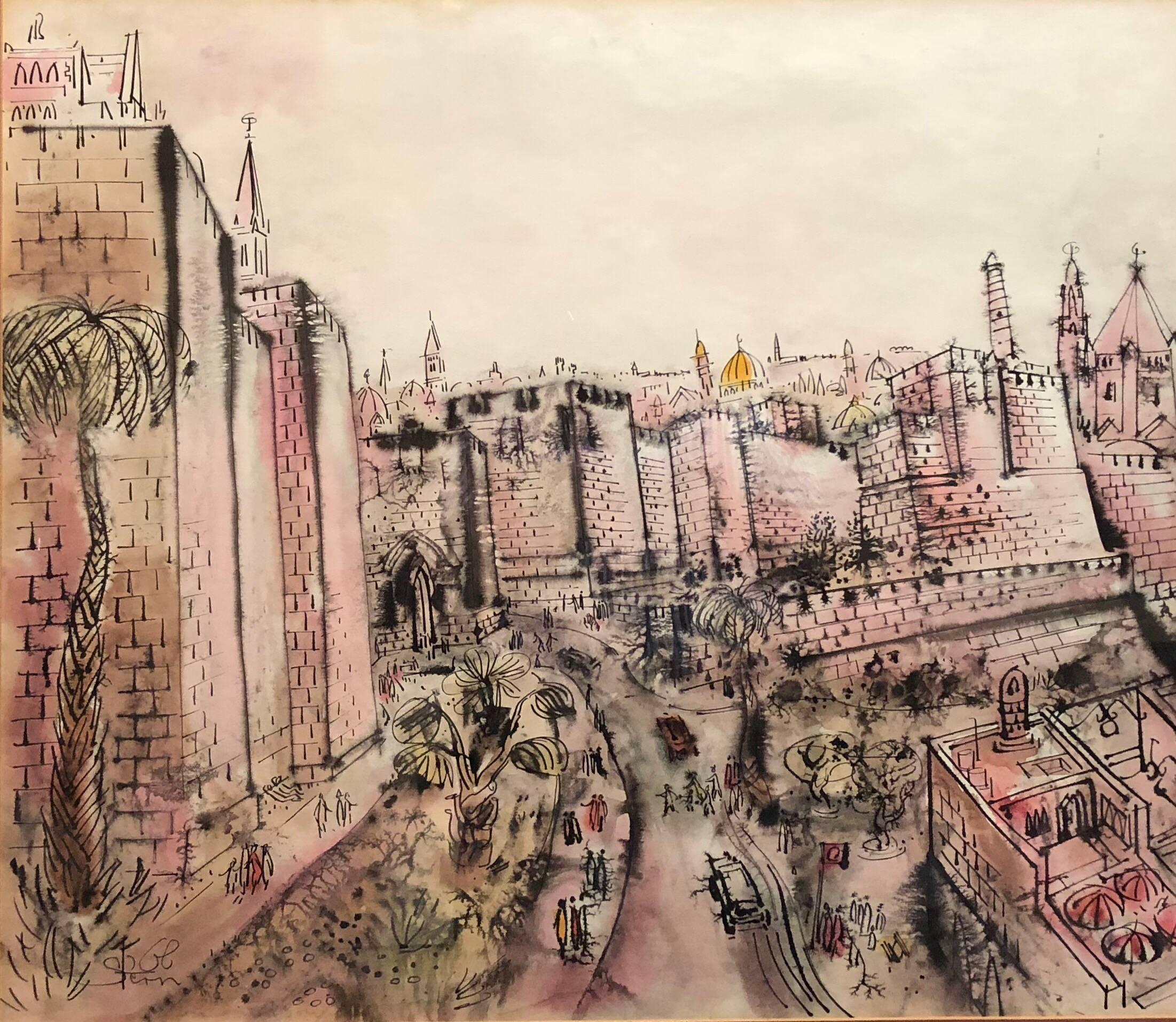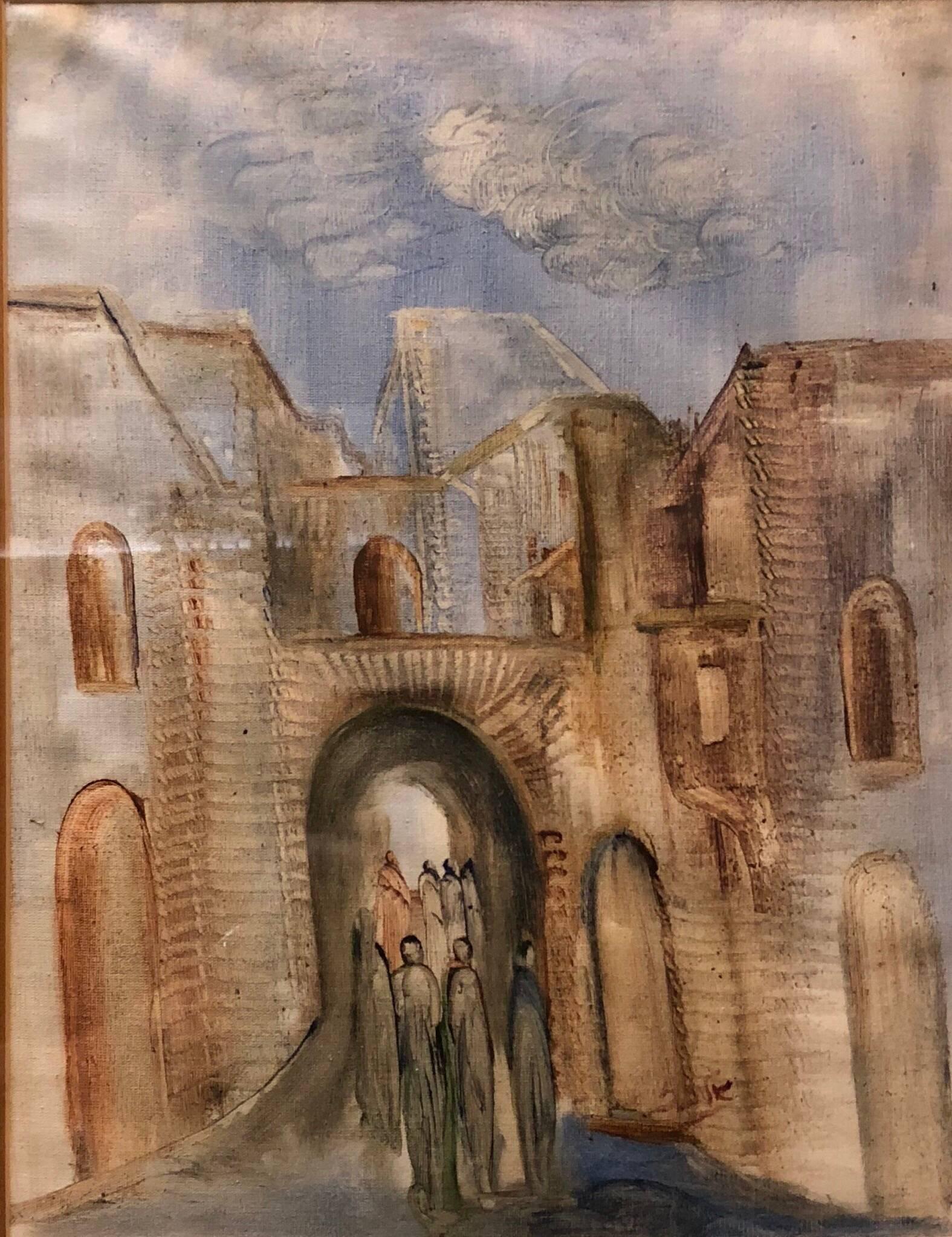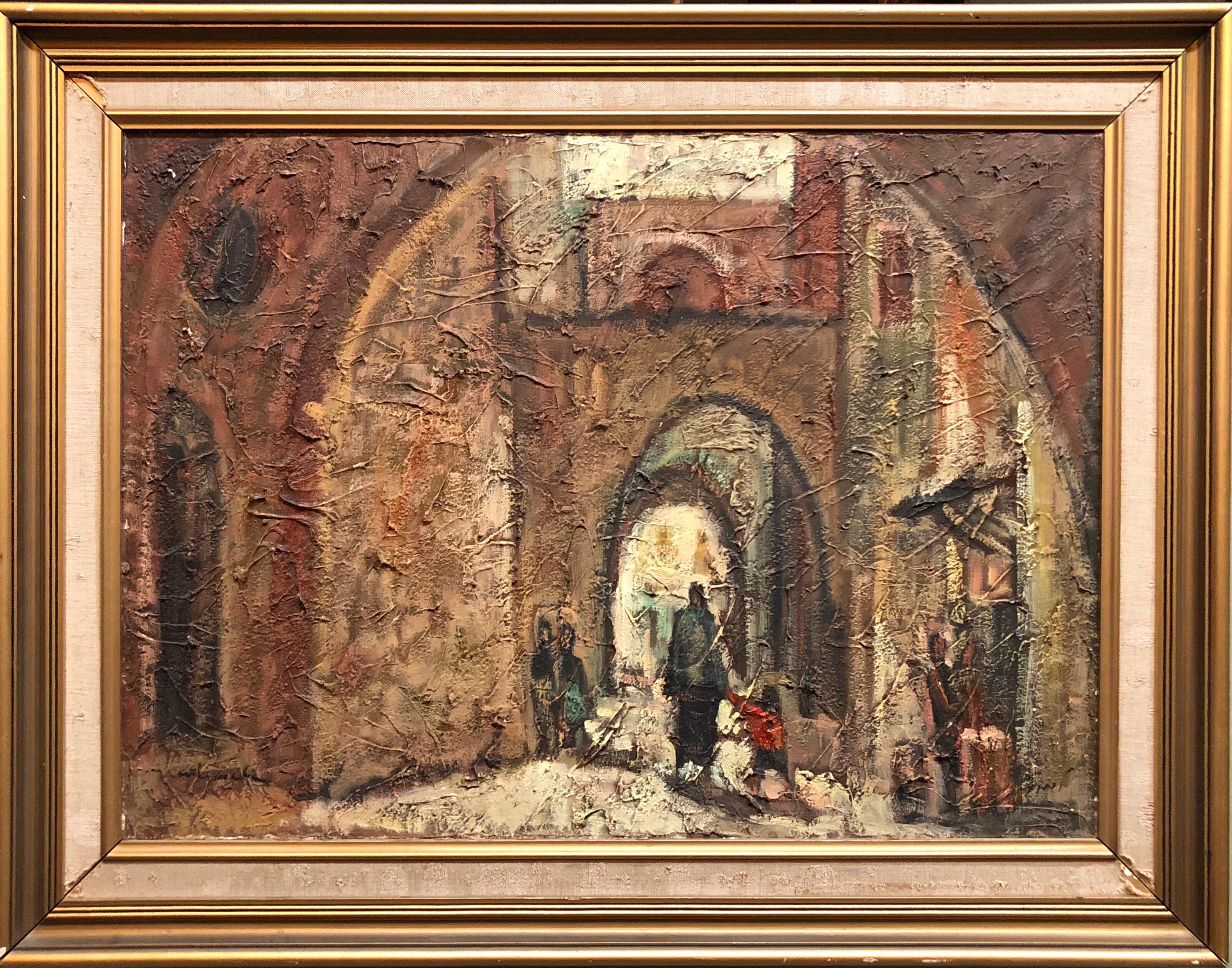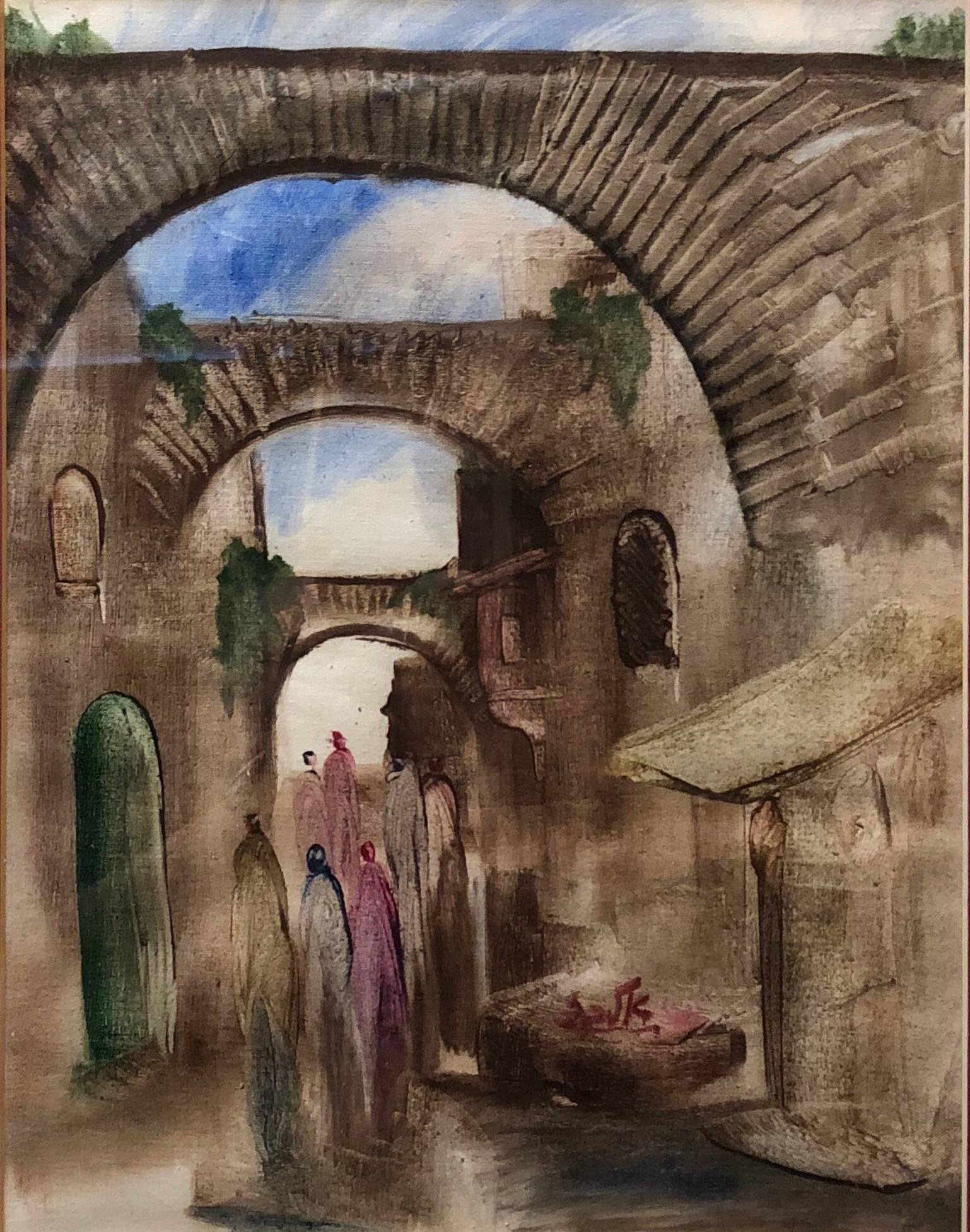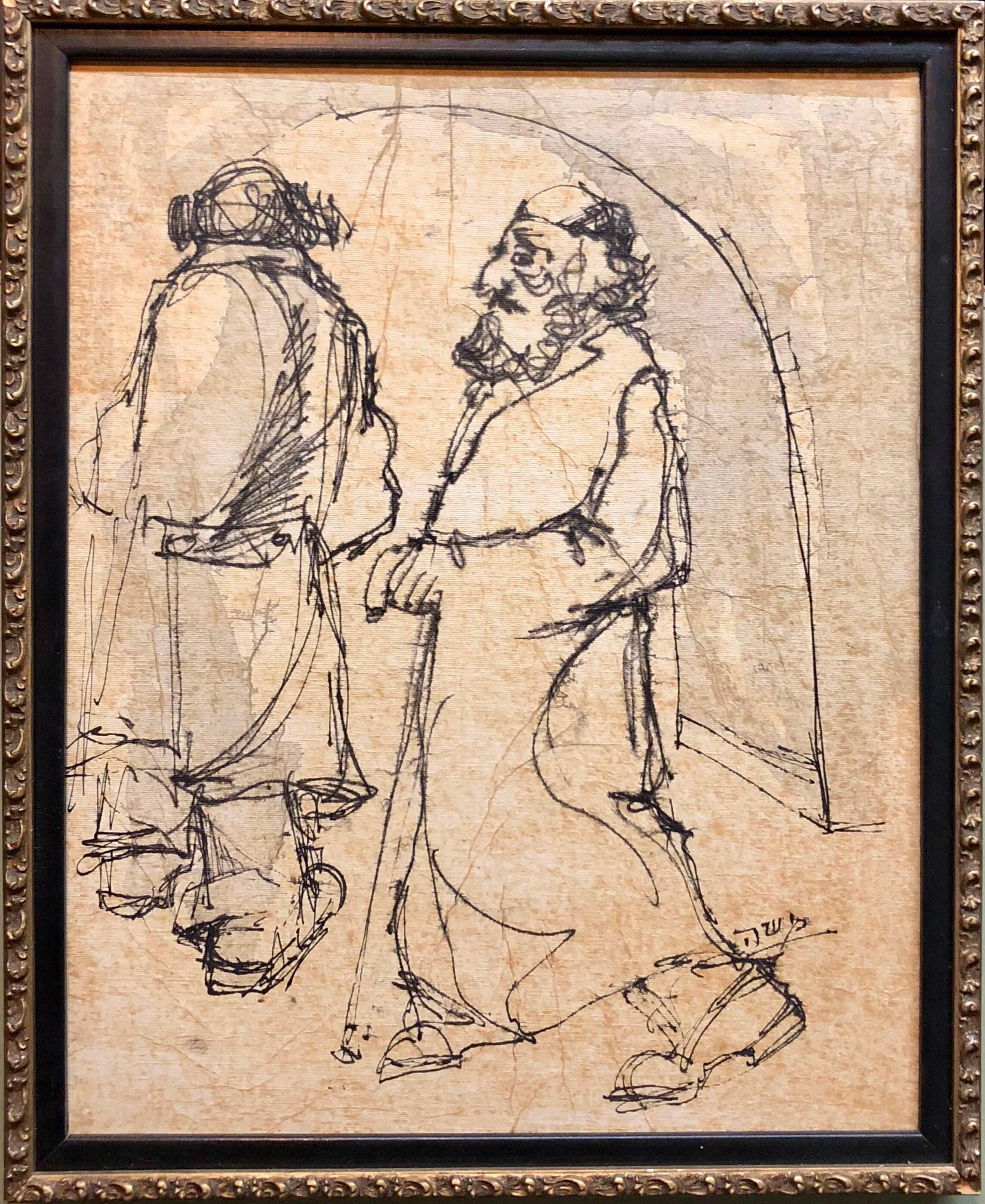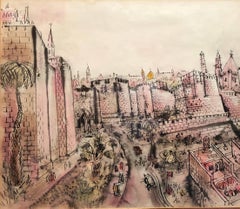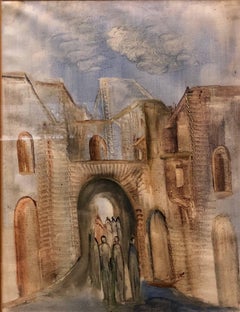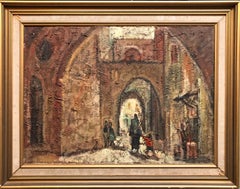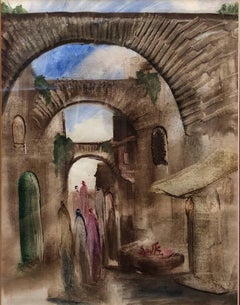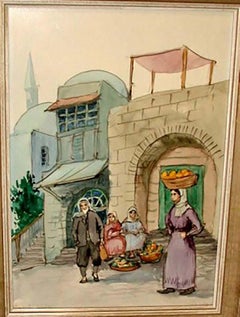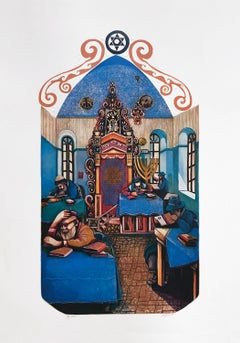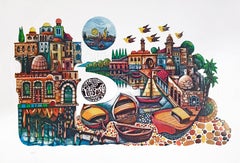Items Similar to Old City Jerusalem City Walls landscape Scene Painting, Judaica
Want more images or videos?
Request additional images or videos from the seller
1 of 11
Jossi SternOld City Jerusalem City Walls landscape Scene Painting, Judaica
$2,000
£1,518.65
€1,736.69
CA$2,794.29
A$3,107.86
CHF 1,622.83
MX$37,819.36
NOK 20,725.99
SEK 19,437.32
DKK 12,961.56
Shipping
Retrieving quote...The 1stDibs Promise:
Authenticity Guarantee,
Money-Back Guarantee,
24-Hour Cancellation
About the Item
Vibrant Gouache and watercolor painting by Israeli master JOSSI STERN. on paper mounted to board.
Dimensions: 29.5 X 33.5 23 X 27
Jossi (Yossi) Stern, (Hungarian Israeli 1923 - 1992)
Son of David and Katerina, was born in the Bakon Hills of Hungary, in 1923. He was already drawing when at the age of ten he moved with his family from the Bakon Hill region to the considerably more cosmopolitan Budapest.
Recognizing the looming threat of Hitler and the pending Nazi invasion of Hungary, in 1940, at the age of seventeen, the young artist made his way to Palestine aboard the Sakaria, an old ship heavily crowded with 2,300 other refugees. Before reaching the shores of Palestine, then under the British Mandate, the British Navy intercepted the ship and declared Stern and all those aboard illegal immigrants. Stern was sent to a prison camp where he remained incarcerated by the British for six months.
In 1943, having spent a few years doing agricultural work, Stern was encouraged by close friends who recognized his artistic talent to enroll in the prestigious Bezalel School of the Arts in Jerusalem. An outstanding student, he eventually became a highly respected teacher of Graphic Arts at Bezalel.
Stern is recognized in Israel as having been one of the country's premier artists. His drawings are exhibited and appear in many publications and museums worldwide. Stern was the recipient of numerous awards including the Jerusalem Medal as well as both the UNESCO and Herzl Prize.
Education
1943-1947 Bezalel Academy of Arts and Design, Jerusalem.
1949 Royal College of Art, London, England, advanced studies.
1950 Paris, France.
Teaching
1947-1970's, Professor at Bezalel Academy of Arts & Design, Jerusalem
Awards And Prizes
1946 Herman Struck Prize for Excellence, Bezalel Academy of Arts and Design, Israel
1967 UNESCO Award
1969 Nordau Prize for Art, Association of Hungarian Immigrants
1978 Herzl Prize
He was included in the exhibition New Bezalel Artists' House, Jerusalem Tel Aviv Museum, along with Artists:
Ludwig Wolpert, Joseph Budko, Gershon Knispel, Gershon Avigdor Arikha, Maryan, Jacob Steinhardt, Ruth Schloss, Mordecai Ardon, Naftali Bezem.
Applied Arts in Palestine 1946
The Bezalel National Museum, Jerusalem, 1946
Artists: Gumbel, David Wolpert, Ludwig Yehuda Yellin Ginat, Judith Schwerin, Ludwig Stern, Yossi Sebba, Shalom
Seven ArtistThe Bezalel National Museum, Jerusalem, 1948
Artists: Bezem, Naftali Hirsch, Joseph Schloss, Ruth Stern, Yossi Stern, Friedel
Jerusalem Artists Spring Exhibition Artists' House, Jerusalem, 1957
Artists: Schatz, Zahara Blum, Ludwig Eisenberg, Jacob Sima, Miron Levanon, Mordechai Aschheim, Isidor Pins, Jacob Schatz, Bezalel (Lilik) Priver, Aaron
The Bezalel National Museum, Jerusalem. 1958
Artists: Ofek, Avraham Uri, Aviva Avigdor Arikha, Yosl Bergner, Myriam Bat Yosef, Miriam Nahum Gutman, Shraga Weil, Zaritsky, Yossef Anna Ticho, Moshe Tamir, Marcel Janco, Levanon, Mordechai Maryan Yohanan Simon Reuven Rubin, Fima Jacob Steinhardt, Jakob Stern, Yossi David Sharir,
- Creator:
- Dimensions:Height: 31 in (78.74 cm)Width: 34.75 in (88.27 cm)
- Medium:
- Movement & Style:
- Period:
- Condition:
- Gallery Location:Surfside, FL
- Reference Number:1stDibs: LU38216012182
About the Seller
4.9
Platinum Seller
Premium sellers with a 4.7+ rating and 24-hour response times
Established in 1995
1stDibs seller since 2014
1,784 sales on 1stDibs
Typical response time: <1 hour
- ShippingRetrieving quote...Shipping from: Surfside, FL
- Return Policy
Authenticity Guarantee
In the unlikely event there’s an issue with an item’s authenticity, contact us within 1 year for a full refund. DetailsMoney-Back Guarantee
If your item is not as described, is damaged in transit, or does not arrive, contact us within 7 days for a full refund. Details24-Hour Cancellation
You have a 24-hour grace period in which to reconsider your purchase, with no questions asked.Vetted Professional Sellers
Our world-class sellers must adhere to strict standards for service and quality, maintaining the integrity of our listings.Price-Match Guarantee
If you find that a seller listed the same item for a lower price elsewhere, we’ll match it.Trusted Global Delivery
Our best-in-class carrier network provides specialized shipping options worldwide, including custom delivery.More From This Seller
View AllOld City Jerusalem City Walls landscape Scene Painting, Judaica
By Jossi Stern
Located in Surfside, FL
Vibrant Gouache and watercolor painting by Israeli master JOSSI STERN. on paper mounted to board. 31x34.75, 23.5x27.5 without frame.
Hungary, b. 1923, d. 1992
Jossi (Yossi) Stern, son of David and Katerina, was born in the Bakon Hills of Hungary, in 1923. He was already drawing when at the age of ten he moved with his family from the Bakon Hill region to the considerably more cosmopolitan Budapest.
Recognizing the looming threat of Hitler and the pending Nazi invasion of Hungary, in 1940, at the age of seventeen, the young artist made his way to Palestine aboard the Sakaria, an old ship heavily crowded with 2,300 other refugees. Before reaching the shores of Palestine, then under the British Mandate, the British Navy intercepted the ship and declared Stern and all those aboard illegal immigrants. Stern was sent to a prison camp where he remained incarcerated by the British for six months.
In 1943, having spent a few years doing agricultural work, Stern was encouraged by close friends who recognized his artistic talent to enroll in the prestigious Bezalel School of the Arts in Jerusalem. An outstanding student, he eventually became a highly respected teacher of Graphic Arts at Bezalel.
Stern is recognized in Israel as having been one of the country's premier artists...
Category
20th Century Modern Figurative Paintings
Materials
Watercolor, Gouache, Illustration Board
Jerusalem Old City Landscape, Expressionist Judaica Israeli Painting II
By Andre Elbaz
Located in Surfside, FL
In this painting the artist uses gestural brushstrokes, which causes distortion and exaggeration for emotional effect. Andre Elbaz uses as his subject figures walking in old city Jerusalem.
André Elbaz (born April 26, 1934, El Jadida, Morocco) is a famous Moroccan painter and filmmaker.
Elbaz studied art and theatre in Rabat and Paris from 1950 to 1961. He started painting only at the age of 21, until which age he had been interested mainly in theatre. A few years later, he managed to combine his two passions into a new approach in art-therapy, inventing together with his wife, a psychiatrist, the Pictodrame, which brought him world recognition.
His first exhibition, which was very successful, took place in Casablanca in 1961 and earned him an appointment as Professor at the Beaux-Arts school in Casablanca. Years later, in 1976, he exhibited his paintings at the Tel-Aviv Museum.
In parallel to his career as a painter, Elbaz is also known as a filmmaker. He produced several short films in France, Canada and the United States. One of them, La nuit n'est jamais complète (The night is never complete), won a prize at the "5th Biennale de Paris in 1967". Among the themes chosen for the many films he produced, there was a short one about the Warsaw Ghetto uprising, as well as a series of drawings entitled Seuls (Alone), with texts written by both Elie Wiesel...
Category
20th Century Expressionist Figurative Paintings
Materials
Paper, Gouache
Jerusalem Old City Cityscape Israeli Modernist Oil Painting Signed in Hebrew
Located in Surfside, FL
Signed Nathanson. Could be the famous artist Avraham Naton (Natanson) I am not certain. it is a very lovely Modernist Israeli landscape.
Avraham Naton (Natanson), Israeli, born in Bessarabia, 1906-1959. Avraham Naton was born in Rani, Bessarabia to a large secular family. In 1935, after Art studies in Romania, he immigrated to the Land of Israel and settled, first, in Givat Haim and later in Ramat Gan. From the 1940s he worked as an Art teacher in Ramat Gan and Givataim. In 1948 he worked as an illustrator at BaMahane Newspaper. He was one of the Founders of New Horizon Group. Between 1952-1959 he was a member of the Milo Club and served as the club secretary.
Education
1930-33 Art Academy, Bucharest, Romania
Teaching
1940's Ramat Gan and Givataim
Awards And Prizes
Jerusalem Prize for Painting and Sculpture
1942 Dizengoff Prize
1953 Milo Club Prize
New Horizons, The Ofakim Hadashim art movement began with a group of artists who mounted an exhibition in Tel Aviv's Habima national theater in December 1942, under the name "The Group of Eight". The group evolved into a coherent artistic movement only after the founding of the state of Israel in 1948. Members of the school included Arie Aroch, Zvi Meirovitch, Avraham Naton (Natanson), Avigdor Stematsky and Yehezkel Streichman. The work of sculptor Dov Feigin also appeared in the catalog of the 1942 exhibition, though it was not displayed. In February 1947 five of the original members of the group joined Joseph Zaritsky...
Category
1950s Modern Landscape Paintings
Materials
Canvas, Oil
Jerusalem Old City Landscape, Expressionist Judaica Israeli Painting
By Andre Elbaz
Located in Surfside, FL
In this painting the artist uses gestural brushstrokes, which causes distortion and exaggeration for emotional effect. Andre Elbaz uses as his subject figures walking in old city Jerusalem.
André Elbaz (born April 26, 1934, El Jadida, Morocco) is a famous Moroccan painter and filmmaker.
Elbaz studied art and theatre in Rabat and Paris from 1950 to 1961. He started painting only at the age of 21, until which age he had been interested mainly in theatre. A few years later, he managed to combine his two passions into a new approach in art-therapy, inventing together with his wife, a psychiatrist, the Pictodrame, which brought him world recognition.
His first exhibition, which was very successful, took place in Casablanca in 1961 and earned him an appointment as Professor at the Beaux-Arts school in Casablanca. Years later, in 1976, he exhibited his paintings at the Tel-Aviv Museum.
In parallel to his career as a painter, Elbaz is also known as a filmmaker. He produced several short films in France, Canada and the United States. One of them, La nuit n'est jamais complète (The night is never complete), won a prize at the "5th Biennale de Paris in 1967". Among the themes chosen for the many films he produced, there was a short one about the Warsaw Ghetto uprising, as well as a series of drawings entitled Seuls (Alone), with texts written by both Elie Wiesel...
Category
20th Century Expressionist Figurative Paintings
Materials
Paper, Gouache
Jerusalem, Old city, Western Wall, 1970 Judaica Watercolor Painting Israeli Art
By Baruch Nachshon
Located in Surfside, FL
Baruch Nachshon, was born in Mandatory Palestine in 1939, in the city of Haifa.
Nachshon began to paint in early childhood, and developed his relationship to art and to artists throughout his youth. During his military service Nachshon herded flocks for the IDF, an experience that imbued in him a love and appreciation for nature which figures prominently in his work until today. Upon completing his military service the young artist was torn between the temptation to travel to Paris, then the cultural center of the art world, and his deep love of the land of Israel, the spiritual center of the Jewish world. Opting to stay in Israel, Nachshon studied under Shlomo Nerani, Cezanne’s only pupil, with whom he had enjoyed a deep friendship extending back to his childhood. Nachshon, whom Nerani viewed as his spiritual heir, was the only one of his students allowed to see the master at work.
Nachshon’s lifelong involvement in Lubavitch Hassidut began in his early adulthood, when he was drawn to the movement by its uniquely beautiful traditional melodies. In 1965 Nachshon was invited to an unprecedented three- hour private session with the Rebbe...
Category
20th Century Modern Landscape Drawings and Watercolors
Materials
Watercolor
Modernist Israeli Judaica Mixed Media Painting Rabbis Walking In Jerusalem
By Moshe Katz
Located in Surfside, FL
Moshe Katz (Romanian Israeli), 1937- an Israeli citizen, studied art at the Bezalel Academy of Art in Jerusalem, as well as at the Chicago Academy of Fine Arts.
Although not an exponent of one dominating technique of painting, Moshe has been fascinated in recent months with the textures and expressions he is able to obtain with the pallette knife.
Picasso, Cezanne and Gaugin are his idols, and the power of Mexican art has a deep fascination for him. With elements of Folk Art combined with a sophisticated technique.
He enjoys working in clay but finds painting in oil his greatest outlet for the stories he has to tell through his pictures. In addition to an outstanding collection of books featuring the works of the great masters, his shelves are lined with texts about hypnosis. Studying about the art of hypnotizing provides him with a mental exercise far removed from his highly developed art of expressing himself on canvas. He has exhibited with the Painters and Sculptors Association in Israel, Haifa and the North along with artists: Yaacov Agam, Sela (Blaustein), Emanuel Pinhassi, Pasternak, Anna, Chaltiel, Joseph Schwartz, Nira Shemer, Aviva, Fadel, Mohamed Bishara, Sana, Menashe Kadishman, Menashe Shalhevet, Yitzchak Frumin, Moshe Rosen, Maureen
Moshe was born March 2, 1937 in Bucherest, Romania with his parents, he fled from the Nazis and after stops in many countries, reached Israel. His paintings have been displayed by Arts International...
Category
20th Century Modern Portrait Paintings
Materials
Canvas, Mixed Media, Acrylic
You May Also Like
Jerusalem Street Scene
Located in Fort Washington, PA
Medium: Watercolor on Board
Signature: Signed Lower Left
Jerusalem Street Scene
Category
20th Century Landscape Drawings and Watercolors
Materials
Watercolor, Board
YASHIVA IN JERUSALEM (JUDAICA ART)
By Amram Ebgi
Located in Aventura, FL
Embossed lithograph with foil stamping on paper. Hand signed and numbered by the artist. From the edition of 300.
Artwork is in excellent condition. Certificate of authenticity in...
Category
Late 20th Century Contemporary Figurative Prints
Materials
Foil
$100 Sale Price
50% Off
Impressionist Landscape Painting of the Holy City of Jerusalem
By Frank Freed
Located in Houston, TX
Lovely impressionistic painting of the Holy City of Jerusalem by Texas artist Frank Freed.
Dimensions of painting itself: H 18 in. x W 24 in.
Artist Biog...
Category
1960s Impressionist Landscape Paintings
Materials
Acrylic
CITY OF JAFFA (JUDAICA ART)
By Amram Ebgi
Located in Aventura, FL
Embossed lithograph with foil stamping on paper. Hand signed lower right by the artist. From the edition of 200.
Artwork is in excellent condition. Certificate of authenticity inc...
Category
Late 20th Century Contemporary Figurative Prints
Materials
Foil
$100 Sale Price
50% Off
View of Jerusalem, Framed Impressionist Landscape Oil Painting
Located in Long Island City, NY
Artist: Unknown XXth Century
Title: View of Jerusalem
Medium: Oil on canvas, signed and titled in Hebrew
Image Size: 19.5 x 26.5 in. (49.53 x 67.31 cm)
Frame Size: 25 x 32 inches
Category
Mid-20th Century Modern Landscape Paintings
Materials
Oil, Canvas
Wedding in Jerusalem
By Zvi Raphaeli
Located in Saratoga Springs, NY
Signed lower left.
Provenance: Private Collection, Boca Raton, Florida
Zwi Raphaeli was an Israeli impressionist painter. He studied in Paris at the Beaux-Arts and the Bezalel Acad...
Category
20th Century Impressionist Figurative Paintings
Materials
Paper, Gouache
More Ways To Browse
Vintage City Wall Art
1940s Illustration
Bezalel Academy
Modern Judaica Painting
1940s British Painting
Vintage Bat Art
Jerusalem 1967
Judaica Bezalel
Royal Navy Painting
Hitler Painting
Palestine Wall Art
Avigdor Bezalel
Palestine 1940
Ruth Hiller
Vintage Eisenberg
Anna Hills
Vintage College Pins
Anna Hill Painting
